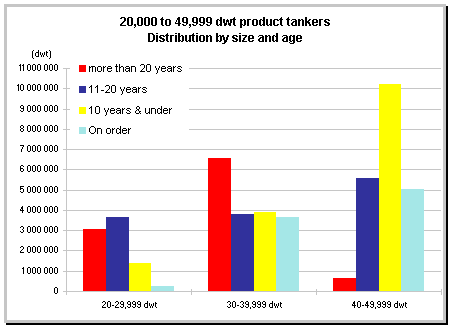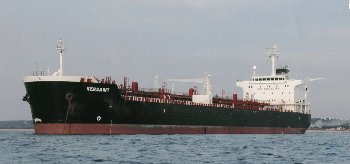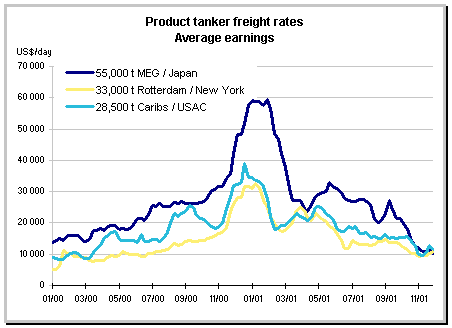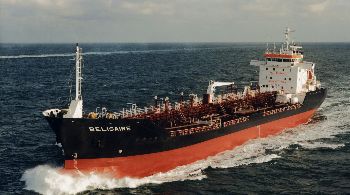
The transport of refined oil products
in 2001 |
|
|
| |
|
With regards to the transport of refined oil
products in 2001, although the year began in euphoric mood it ended in one
of uncertainty and according to some analysts even of pronounced
pessimism. Owners and charterers together expect 2002 to be a difficult
year.
Nonetheless, 2001 will go down as being a vintage year for product
tanker shipowners. Daily returns for ships operating on the spot market
were on the whole higher than those of 2000, which in themselves were
excellent.
Although the drop at the beginning of the year was a technical
correction and largely predictable, nobody thought that the levels
achieved, more than $50,000 per day for the LR and more than $30,000 per
day for the MR, could be maintained. It was generally thought that the
market would find an equilibrium in the middle of the year, but it was not
the case: the drop in rates which began in May started gathering speed
month after month to finish the year at the levels of end 1999.
The freight market for product tankers suffered a continuous drop in
revenues throughout the year 2001 for all sizes
|
| The
'handysize' (handy product) from 25,000 to 40,000 dwt |
|

|
|
It is in this category that the imbalance
between supply and demand was greatest at the beginning of the year,
resulting in returns of over $30,000 per day. Not helped by the delivery
of more than 30 newbuildings, it was the weak American and to a lesser
degree the European demand that explains the dramatic drop in revenues
which attained at the end of the year levels close to $10,000 per day.
The creation of the Handy Tankers K/S pool, formed around AP Moller,
Seaarland Motia and d'Amico Tankers which consists of 25 ships in 2001,
led certain oil companies to cover their medium-term tonnage needs. BP
took control of seven ships in this size, as well as CSSA, while Shell,
Agip and Tamoil all took on two each.
Either by chance or as a result of this policy, the pool does not seem
at least for the moment to have accumulated a sufficient share in the
deals concluded to have had a significant impact on rates.
|
 |
Kersaint
37,263 dwt, blt 2001 by Hyundai Mipo, owned by Socatra |
|
| The
'medium range' (MR product) from 40,000 to 50,000 dwtl
|
|
|
Following the delivery of 11 ships in 2001,
this category of the fleet of product tankers is the most modern with
two-thirds of ships being less than 10 years.
As for the 35,000 tonners, many charters have been concluded for
periods of two years or more, notably for account of Stasco (five),
Coastal-El Paso (three), ExxonMobil (two), and Glencore (three) at rates
between $16,000 and $18,000 per day.
Naturally given to covering inter-zone voyages, these ships suffered
from the shortening of their voyages as soon as American demand fell-off
as from the month of June, and their daily returns which were over $35,000
per day at the beginning of the year collapsed to $11,000 per day in
December. As from October they also suffered from a lack of activity in
the Far East.
|
| The
'long range' (LR product) from 55,000 to 110,000 dwt
|
|
|
This category benefited from the good performance of the market in the
Far East during the first half of the year, during which their daily
returns always remained above $30,000 per day and sometimes went up to
$50,000 per day. The second-half was more difficult due to the fall in
Japanese demand and a virtual disappearance of jet voyages MEG/Europe as
from September.
The LR1 were largely used for exports of jet from Middle East Gulf or
from the Indian Ocean, as well as voyages of gas oil and fuel oil from
Europe to the U.S. The few very modern ships (less than five years) saw
rates of close to $20,000 per day for periods of one to five years.
The existence of the "LR2 pool" and contracts at variable
levels based on different indices (notably Platts) helped to avoid a
really sharp fall in rates for these ships, although the result was
achieved at the cost of considerable waiting time which affected daily
returns.
The explanation of the slow but steady drop in
product tanker freight rates is due more to a fall in demand than a rise
in availability.
|

|
| The
demand
|
|
The
U.S. down
The North American zone represents more than
30 % of world demand for oil products (45 % of gasoline demand). However
U.S. consumption fell as from the beginning of the second quarter, well
before the terrorist attacks of September 11th which merely amplified to a
larger extent the decline. The most spectacular example can be found in
jet consumption for the month of November 2001 which was 20 % lower than
that of November 2000, although the annual consumption for jet and diesel
oil was 3 % higher. In November 2001, distillate stocks (gas oil, diesel,
and jet) were 15 % above those of November 2000, whilst stocks of gasoline
were 10 % higher than the previous year.
|
Europe
lagging behind
European demand was not able to pick up the
slack, partly because it only represents a small proportion of world oil
product demand and partly because its growth rate of 1.6 % was
insufficient. Although European buyers have become a privileged target of
exporters from the Middle East Gulf, the Far East and more recently India,
this traffic which is a strong generator of tonnes-miles, stumbled at the
end of the year principally due to a big drop in jet imports (the daily
consumption falling by 14 % in November).
In addition, whilst petrochemical demand has slowed considerably,
German distillate stocks at the end of the year are at their historic
highs.
|
The
Far East on a cliff edge?
Japan's inability to extract itself from its
structural crisis and the exposure of several emerging economies to
external contractions (the crisis in tourism and electronics) has led to
stagnating demand for oil products within the Far East. As such the annual
consumption of jet and diesel in Asia has fallen by 2 % in 2001. The
increase in local refinery capacity (Korea, Indonesia, Thailand, and
especially India) has favoured regional exchanges and resulted in shorter
voyages and cut off the flow of exports towards Europe and the U.S. west
coast, which contributed to the good performance of freight rates last
year.
The fear of a major crisis in Japan, which could then ricochet on the
fragile economies of Korea and Indonesia, contributes to the pessimism in
the minds of many observers. The risk of a serious impact on the world
scene cannot be excluded.
|
| The
fleet
|
|
|
Despite the need to
renew the fleet of product tankers, a flood of orders could unbalance the
market.
The fleet of handysize (30,000 /
40,000 dwt) increased by 29 units in 2001 for a total of over the million
dwt mark. Forty-two additional units should be delivered in 2002 and 47 in
2003, whereas only 17 ships are programmed for 2004. One hundred and
thirty five new ships will have be delivered in four years, nearly a third
of the existing fleet.
The fleet of medium range has grown
by only 11 ships delivered this year for a total of about 500,000 dwt, but
30 ships should be delivered in 2002, 53 in 2003 and 20 in 2004. In 2005
two-thirds of the fleet will be less than 15 years old.
As to the largest size, four were
delivered this year, 11 will be put on the market in 2002 and 25 in 2003.
However charterers have adopted extremely strict quality criteria,
especially on age, which considerably reduces the number of eligible
ships. This has become a very sensitive issue in the handysize sector
where nearly 50 % of the ships have become practically unemployable.
Despite the pessimistic outlook for the short-term, it is reasonable to
expect an improvement in the medium-term if the anticipations do not
stifle the expected recovery at birth.
It is obvious that stock positions at year's
end and stagnant demand for oil products do not encourage optimism.
Nevertheless the elasticity of tonnage on offer remains relatively
small due to increased concerns on quality. It might suffice therefore
that the recovery of the American economy lives up to the analysts'
hopes for the third quarter of 2002 and that Japan manages its revival for
an increase in oil product demand to produce a rapid and substantial rise
in freight rates. After all, isn't it what happened at the start of
2000, when rates were at their lowest?
While an exaggerated pessimism seems out of place in the short term,
there is still a risk in the medium-term with a financial market
historically favourable combined with a lowering of construction costs
leading to a wave of orders which in turn would produce a tonnage surplus,
that would unbalance the product tanker freight market for a long time to
come
|
 |
Belisaire
12,681 dwt, blt 2001 by Niestern Sander, owned by Petromarine |
|
| Product
tankers second-hand market
|
|
|
Some 92 ships of 25,000 to
60,000 dwt were sold for further trading in 2001, compared to 67
transactions last year. Fifty-four units were handysize, 31 were medium
range and seven were in the long range size.
Eighteen sales were carried out for ships built in the 70's (last
stop before demolition?), 31 for units delivered in the 80's, and 43 for
tankers built in the 90's.
Amongst the latter, some 20 were less than three years old. Owners
wishing to renew their fleet, and taking advantage of well-sustained
freight market at the beginning of the year, produced it has been noticed
a feverish activity on the resale of ships under construction, with
short-term deliveries obtaining at least up until June a premium over
longer term deliveries.
OMI Corp. (U.S.) was certainly amongst the most active, buying not less
than 16 modern ships in the medium range category, with a number of them
being under construction.
A part of the ships sold were done en bloc and often with attached
charters or charters back. Notable buyers other than OMI Corp., were
clients of the Livanos group (five ships with charters back) and also
clients of the Stelmar group (10 Osprey ships).
After record freight levels achieved at the end of 2000 / beginning of
2001, the serious slowdown of the world economy throughout the year
weakened rates, which suffered a continual decline with intermittent blips
to plunge precipitously mid year. The events of September 11th only
reinforced this tendency which got reflected for real upon the value of
second-hand ships.
We indicated last year an increase in values of the order of 15 to 25 %
for modern units. This year the trend is clearly the reverse as prices
have dropped by 18 to 20 % according to size and age.
Since January 2001, 41 ships have been delivered for 1.57 million dwt.
At the same time, 28 ships for a total of 0.97 million dwt have been
withdrawn from the fleet, but the orderbook holds 221 product tankers for
a capacity of 8.97 million dwt, of which 77 for delivery in 2002 and 104
in 2003. Combined with a slowdown in the world economy, this additional
capacity will indubitably weigh upon rates and therefore on second-hand
values.
We would like to think that owners could refrain from having such big
appetites when ordering, but the anticipated weakness of the yen, the
likely reduction in construction costs and the low interest rates will
doubtless make it irresistible for some. This will inevitably affect the
second-hand values of even the most modern ships. .
|
Shipping and Shipbuilding Markets in 2001
I N D E X
|